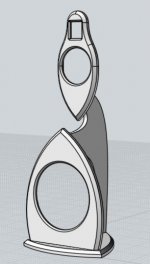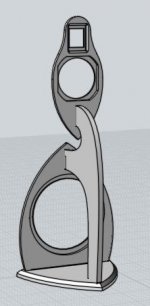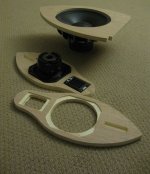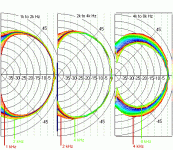Going back to NaO Note topology, I tried once getting uniform response up to 10khz. Which is pretty high for dipole standard.
http://www.diyaudio.com/forums/mult...polar-response-tweeters-last.html#post2091908
Gainphile: S13 OB - Fullrange dipole tweeters
However I found that it does not sound right, somewhat. I could not explain the phenomenon and the best description is the difference of baffle width affected the realism of the presentation. In fact I preferred the constant baffle width over it. Although it is less uniform.
Do you see any perceptual drawback comparing NaO to NaO note?
http://www.diyaudio.com/forums/mult...polar-response-tweeters-last.html#post2091908
Gainphile: S13 OB - Fullrange dipole tweeters
However I found that it does not sound right, somewhat. I could not explain the phenomenon and the best description is the difference of baffle width affected the realism of the presentation. In fact I preferred the constant baffle width over it. Although it is less uniform.
Do you see any perceptual drawback comparing NaO to NaO note?
Somewhat following in John's footsteps:
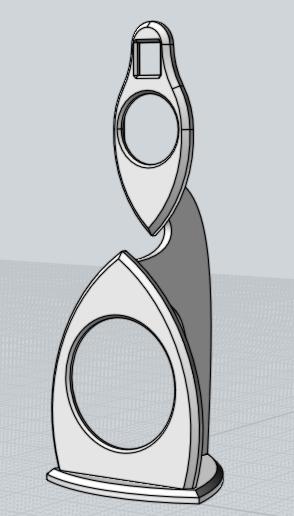
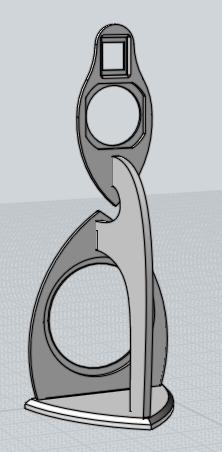
That was an idea I'd sketched out many months ago, but it's way beyond my construction skills. A friend recently set up a CNC machine, so we've started cutting out some pieces:
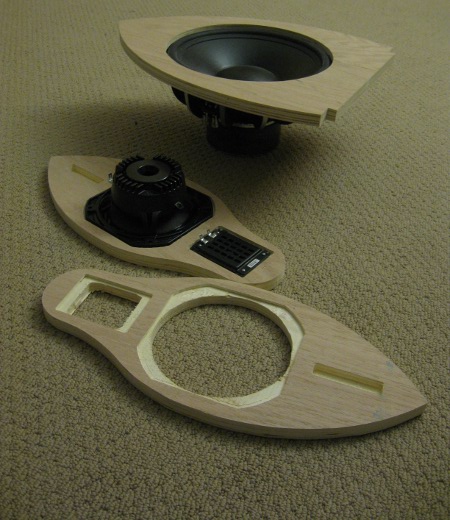
I hope to have something to measure in a few days.
That was an idea I'd sketched out many months ago, but it's way beyond my construction skills. A friend recently set up a CNC machine, so we've started cutting out some pieces:
I hope to have something to measure in a few days.
Attachments
Hi !
I have observed this same phenomena. I prefer the sound of a rectangle baffle instead a trapeze one. S. Linkwitz seems to have a begin of explanation but not well known, a research area to do : interaction between the room and the shape of the baffle. How a shape affects the sound in correlation with the room. I think your room is very different from mine and you observed this thing, this theory could be not very realistic. It should be only how the shape affects the waveform ?
Regards.
I have observed this same phenomena. I prefer the sound of a rectangle baffle instead a trapeze one. S. Linkwitz seems to have a begin of explanation but not well known, a research area to do : interaction between the room and the shape of the baffle. How a shape affects the sound in correlation with the room. I think your room is very different from mine and you observed this thing, this theory could be not very realistic. It should be only how the shape affects the waveform ?
Regards.
Going back to NaO Note topology, I tried once getting uniform response up to 10khz. Which is pretty high for dipole standard.
http://www.diyaudio.com/forums/mult...polar-response-tweeters-last.html#post2091908
Gainphile: S13 OB - Fullrange dipole tweeters
However I found that it does not sound right, somewhat. I could not explain the phenomenon and the best description is the difference of baffle width affected the realism of the presentation. In fact I preferred the constant baffle width over it. Although it is less uniform.
Do you see any perceptual drawback comparing NaO to NaO note?
My last response to you on history, mac. Your concern about selling the NaO II against the Orion is somewhat unfounded as it is certainly common practice to allow people to audition speakers along side other speakers they are considering. I guess you concern is or was that the NaO II truly does out perform the Orion.
No John, that's not my concern. You built the speaker in a hap-hazard manner using SoundEasy to emulate the crossover transfer functions. Additionally, you built them to demo off-of... to sell your wares. IMHO, that is a somewhat sleazy thing to do. I'm somewhat disheartened you don't see it that way.
... and finally ended up with a pair of Geddes speakers after auditioning them. Yuck!
Now there's a point you'll have me in total agreement.
Do you object to me making actuate technical comments and taking legitimate opposing positions?
Nope, not at all. It benefits everyone.
All this is history and it is really time to move on.
Agreed. Just wanted to (try to) set the record straight.
I am happy to discuss any issues you may have with the design of the Note. I am well aware that it is not perfect. But it does represent an improvement in maintaining constant directivity in a dipole format, and consequently more uniform power response, to higher frequencies than has been presented in other designs. That was a primary design objective. The target for reproduction will be to have similar tonal balance as the NaO II.
It's all good!
Cool.
No John, that's not my concern. You built the speaker in a hap-hazard manner using SoundEasy to emulate the crossover transfer functions. Additionally, you built them to demo off-of... to sell your wares. IMHO, that is a somewhat sleazy thing to do. I'm somewhat disheartened you don't see it that way.
That is inaccurate. I addressed this before. Once more, for the record. SE was never use to emulate the crossovers. A digital crossover of any type was never used. SE was used (could have used SPICE, or any other circuit simulator) to lay out the circuits from SL's ASP block diagram and check to see that the simulated transfer functions agreed with those published on SL Orion Challenge web page. I combined a few opamp stages to simplify the circuits. I then build these analog circuits. In response to the reaction of several Orion owners I purchased the plan set and PCB's from SL. In any event anyone who listened to the Orion at my home heard it after I threw out an olive branch and purchased SL's plans and circuit boards. What they heard was 100% Orion, built 100% to the plans I received. You are free to your opinion, however, there was nothing sleazy about it. Right from the start I was up front about having built the Orion for comparison to the NaO. If I had not been so, this whole chain of discussion wouldn't exist.
It's all moot now because I no longer have the Orions.
[edit] You know, the actual reason I build the Orion was because I wanted to hear them.
Last edited:
I really can't comment on comparisons to the NaO II at this time. But I can't see any really difference between using a contoured baffle for a dipole and what Jon Dahlquist pioneered yeas ago in using different sized baffles for different frequency ranges. And it is certainly not different than what Vandersteen does, or B&W and other are doing today.
Saurav,
If my experience is any guide, I suspect you will have problems with the Neo 3 mounted like that.
Saurav,
If my experience is any guide, I suspect you will have problems with the Neo 3 mounted like that.
Thanks for the heads-up. I haven't measured these yet, and it was mostly an attempt to improve the aesthetics of a nude Neo3. What exactly would you suggest changing? Narrow the baffle around the driver? Add more 'waveguide' depth on the back? Reduce the 'waveguide' depth in front?If my experience is any guide, I suspect you will have problems with the Neo 3 mounted like that.
Thanks for the heads-up. I haven't measured these yet, and it was mostly an attempt to improve the aesthetics of a nude Neo3. What exactly would you suggest changing? Narrow the baffle around the driver? Add more 'waveguide' depth on the back? Reduce the 'waveguide' depth in front?
I would suggest making the WG symmetric front and rear. I could not get a good on axis/polar response without doing that.
I don't want to hijack this thread any more than I already have
Don't worry about that.
Hello John k...
Will you be designing the on axis response to have slightly rising slope, exact horisontal or sligthly falling slope?
- Elias
That is the beauty of the hybrid design approach. The active crossover/eq between woofer and panel will have both adjustable bass and treble. I design the speaker for flat response but I realize that everyone has their own preferences and rooms to deal with. I strive to get the midrange right. If you don't like "tone controls" in the circuit, once you get the speaker setup to your liking a couple of fixed resistors can be used to replace the pots used for adjustment.
What happens after 15khz? Is that drop the inherent response of the Neo3 ?
Seems to be, at least with the samples I have.
I have posted more data on the NaO Note at my web site .
John,
after thinking some time over your polars I can understand why Earl does not like that kind of presentation. Laying one curve on top of another and doing that for approx. two dozen curves can give an impression of harmonious continuity where not much harmony exists.
I am not sure where the frequencies start and end in your diagrams. Are my indications right?
If I am right, I see two areas where I would be interested to know more about your design considerations:
The Scan Speak Discovery develops a tendency to weaken the dipole null at 90° just from the start, peaking at 2 kHz with almost 15 dB "gain" at 90° off axis and recovering 10 dB "loss" from there to 4 kHz. From that I suspect that a 60° to 120° comparison for the SS would be much less impressive than the comparison of on-axis and rear response, that you are showing. How important (or not) would you consider a constantly deep 90° null?
Your 4-8 kHz diagram shows that lobing already starts at 7-8 kHz. It is preceded by continuous beaming from 4 kHz up and another weakening of the dipole null at 90°. Your 9-10 kHz diagram is not the last example of a non-lobing-frequency IMHO, but the last nice-looking curve between 7 and 16 kHz.
My own experiments gave me the impression that designing for a smooth 30° response (and forgetting about 0°) results in less lobing above 8 kHz than what you achieved. But that would need a naked Neo 3, forbidding anything like a baffle or WG around the driver. Did you consider to design for anything else than 0°?
Rudolf
Attachments
I am not sure where the frequencies start and end in your diagrams. Are my indications right?
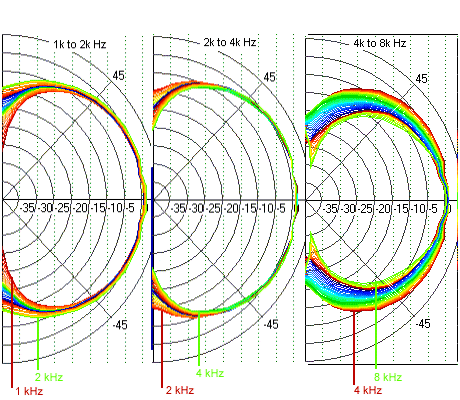
Rudolf
I prefer the mls directivity waterfall view myself. Sound Easy now has that.
As an aside, me, for one. I don't recall anything at Music and Design which clearly indicates the directivity limitations but it was the observations on front to back alignment which led me to opt to DIY my own dipole instead of building an Orion.(Of course who ever listened to me regarding the Orion?)
- Status
- This old topic is closed. If you want to reopen this topic, contact a moderator using the "Report Post" button.
- Home
- Loudspeakers
- Multi-Way
- NaO Note preview
